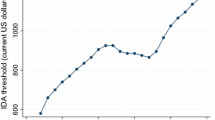Abstract
This paper examines whether foreign aid in education has a significant effect on growth. We take into consideration the heterogeneous nature of aid as well as the heterogeneity of aid recipients—we disaggregate the aid data into primary, secondary, and higher education, and run separate regressions for low income and middle income countries. We find that the effect of aid varies by income as well as by the type of aid. Thus our results underscore the importance of the heterogeneity of aid flows as well as the heterogeneity of recipient countries when analyzing the effect of aid on growth.
Similar content being viewed by others
References
Appiah, E. N., and W. W. McMahon (2002). The Social Outcomes of Education and Feedbacks on Growth in Africa. Journal of Development Studies 38 (4): 27–68.
Arellano, M., and S. Bond (1991). Some Tests of Specification for Panel Data: Monte Carlo Evidence and an Application of Employment Equations. Review of Economic Studies 58 (2): 277–297.
Arellano, M., and O. Bover (1995). Another Look at the Instrumental Variable Estimation of Error Component Models. Journal of Econometrics 68 (1): 29–51.
Blundell, R., and S. Bond (1998). Initial Conditions and Moment Restrictions in Dynamic Panel Data Models. Journal of Econometrics 87 (1): 115–143.
Burnside, C., and D. Dollar (2000). Aid, Policies, and Growth. American Economic Review 90 (4): 847–868.
Burnside, C., and D. Dollar (2004). Aid, Policies, and Growth: Revisiting the Evidence. World Bank Policy Research Working Paper 3251. World Bank, Washington, D.C.
Clemens M. A., S. Radelet, and R. Bhavnani (2004). Counting Chickens When They Hatch: The Short-Term Effect of Aid on Growth. Center for Global Development Working Paper 44. Washington, D.C.
Dalgaard, C.-J., H. Hansen, and F. Tarp (2004). On the Empirics of Foreign Aid and Growth. Economic Journal 114 (496): 191–216.
Dreher, A., P. Nunnenkamp, and R.Thiele (2006). Does Aid for Education Educate Children? Evidence from Panel Data. Kiel Working Paper 1290. Kiel Institute for the World Economy, Kiel.
Doppelhofer, G., X. Sala-i-Martin, and R. Miller (2004). Determinants of Long-Term Growth: A Bayesian Averaging of Classical Estimates (BACE) Approach. American Economic Review 94 (4): 813–835.
Easterly, W., R. Levine, and D. Roodmand (2004). New Data New Doubts, A Comment on Burnside and Dollar’s Aid, Policies, and Growth (2000). American Economic Review 94 (3): 774–780.
Gomanee K., G. Sourafel, and O. Morrisey (2003). Aid, Public Spending and Human Welfare, Evidence from Quantile Regressions. CREDIT Research Paper 3/13. Centre for Research in Economic Development and International Trade, University of Nottingham.
Hansen, H., and F. Tarp (2001). Aid and Growth Regressions. Journal of Development Economics 64 (2): 547–570.
Harms, P., and M. Lutz (2004). The Macroeconomic Effects of Foreign Aid: A Survey. Working Paper 2004-11. University of St. Gallen.
Kakwani N., and H. H. Son (2006). How Costly Is It to Achieve the Millennium Development Goal of Halving Poverty between 1990 and 2015. United Nations Development Program Working Paper 19. International Poverty Center, New York.
Keller, K. R. I. (2006). Investment in Primary, Secondary and Higher Education and the Effects on Economic Growth. Contemporary Economic Policy 24 (1): 18–34.
Krueger, B. A., and M. Lindahl (2001). Education for Growth: Why and for Whom? Journal of Economic Literature 39 (4): 1101–1136.
Leoning, J. (2005). Effects of Primary, Secondary and Tertiary Education on Economic Growth: Evidence from Guatemala. World Bank Policy Research Working Paper 3610. World Bank, Washington, D.C.
Levine, R., and D. Renelt (1992). A Sensitivity Analysis of Cross-Country Growth Regressions. American Economic Review 82 (4): 942–963.
Lucas, R. E. (1988). On the Mechanics of Economic Development. Journal of Monetary Economics 22 (1): 3–42.
Mavrotas, G. (2005). Aid Heterogeneity: Looking at Aid Effectiveness from a Different Angle. Journal of International Development 17 (8): 1019–1036.
Mankiw, N. G., D. Romer, and D. N. Weil (1992). A Contribution to the Empirics of Economic Growth. Quarterly Journal of Economics 107 (2): 407–437.
McMahon, W. (1998). Education and Growth in East Asia. Economics of Education Review 17 (2): 159–172.
Michaelowa, K., and A. Weber (2006). Aid Effectiveness Reconsidered: Panel Data Evidence for the Education Sector. HWWA Discussion Paper 264. Hamburg.
Odedokun, M. (2004). Multilateral and Bilateral Loans versus Grants: Issues and Evidence. World Economy 27 (2): 239–263.
OECD (Organisation for Economic Cooperation and Development) (2006). International Development Statistics. Available at <http://www.oecd.org/dataoecd/50/15/5037782.htm>.
Nelson, R. R., and E. S. Phelps (1966). Investment in Humans, Technological Diffusion, and Economic Growth. American Economic Review 56 (2): 69–75.
Petrakis, P. E., and D. Stamatakis (2002). Growth and Educational Levels: A Comparative Analysis. Economics of Education Review 21 (2): 513–521.
Rajan, R., and A. Subramanian (2005). “Aid and Growth: What Does the Cross-Country Evidence Really Show?” IMF Working Paper WP/05/127. International Monetary Fund, Washington, D.C.
Ram, R. (2003). Role of Bilateral and Multilateral Aid in Economic Growth of Developing Countries. Kyklos 56 (1): 95–110.
Rodrik, D., A. Subramanian, and F. Trebbi (2004). Institutions Rule: The Primacy of Institutions over Geography and Integration in Economic Development. Journal of Economic Growth 9 (6): 131–165.
Romer, P. M. (1990). Endogenous Technological Change. Journal of Political Economy 98 (5): S71–S102.
UN (United Nations) (2000). Millennium Declaration. Available at <http://www.ohchr.org/english/law/millennium.htm>.
Author information
Authors and Affiliations
Corresponding author
Additional information
JEL no.
F34, F35, I20, O19
About this article
Cite this article
Asiedu, E., Nandwa, B. On the Impact of Foreign Aid in Education on Growth: How Relevant Is the Heterogeneity of Aid Flows and the Heterogeneity of Aid Recipients?. Rev World Econ 143, 631–649 (2007). https://doi.org/10.1007/s10290-007-0125-9
Issue Date:
DOI: https://doi.org/10.1007/s10290-007-0125-9



